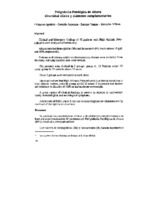Mostrar el registro sencillo del ítem
Poliglobulia patológica de altura, diversidad clínica y exámenes complementarios
| dc.contributor.author | Aparicio, Octavio | |
| dc.contributor.author | Antezana, Gerardo | |
| dc.contributor.author | Vargas, Enrique | |
| dc.contributor.author | Villena, Mercedes | |
| dc.date.accessioned | 2019-02-26T14:22:02Z | |
| dc.date.available | 2019-02-26T14:22:02Z | |
| dc.date.issued | 1990 | |
| dc.identifier.uri | http://repositorio.umsa.bo/xmlui/handle/123456789/18987 | |
| dc.description.abstract | Abstract. Clinical and laboratory findings of 42 patients with High Altitude Polycythemia were analyzed consecutively. All patients had hemoglobin (Hb) and hematocrit (Ht) levels above 19 g/dl and 60%, respectively. Patients with obesity and/or cardiorespiratory disease were excluded from the study. All lung function tests were normal. The patients were divided in 2 groups: group A: 11 Patients under 35 years; group B: 31 patients above 35 years. These 2 groups were compared to each other. The results show that High Altitude Polycythemia is a clinical condition in high altitude natives, even in young adults in whom 2 important risk factors are residence at altitudes of 4000 m and moderate overweight. A great variety of clinical findings is present in relation to cardiorespiratory, hematological and neurological symptoms. Alterations of EKG, chest X ray and echocardiogram are characterized by overload of the right chambers. | es_ES |
| dc.language.iso | es | es_ES |
| dc.publisher | Universidad Mayor de San Andrés | es_ES |
| dc.subject | POLIGLOBULIA | es_ES |
| dc.subject | ALTURA | es_ES |
| dc.title | Poliglobulia patológica de altura, diversidad clínica y exámenes complementarios | es_ES |
| dc.type | Article | es_ES |

